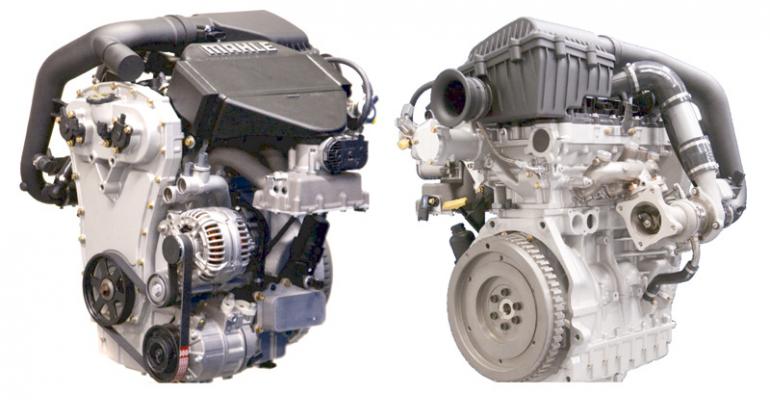FARMINGTON HILLS, MI –It wasn’t long ago that U.S. car buyers thought more always was better when it came to cylinders. That attitude is changing.
A new breed of powerful and fuel-efficient turbocharged 4-cyl. engines in luxury sedans and mainstream vehicles is starting to convince consumers they won’t miss their cherished V-6s and V-8s, especially when it comes time to fill up at the pump.
A test drive of auto supplier Mahle’s latest 3-cyl. prototype suggests a new generation of even smaller and more powerful engines may allow auto makers to drop yet another cylinder without consumers noticing or caring.
In the 1980s and 1990s, 3-cyl. engines were available in bargain-basement econoboxes such as the Suzuki Swift, Geo Metro and Subaru Justy, where they earned a reputation for weak output and poor noise, vibration and harshness characteristics.
Since then, triples have been vastly improved – and turbocharged.
 Ford is racking up awards in Europe for its new 1.0L EcoBoost I-3, which will be offered in the U.S. next year in the Fiesta. BMW now has a 1.5L 3-cyl. in its lineup, and General Motors confirms it has a new I-3 on the way.
Ford is racking up awards in Europe for its new 1.0L EcoBoost I-3, which will be offered in the U.S. next year in the Fiesta. BMW now has a 1.5L 3-cyl. in its lineup, and General Motors confirms it has a new I-3 on the way.
Mahle’s 3-cyl. is powerful, smooth and quiet, even though it has no balance shafts and has a digitally printed prototype intake manifold made from a plastic with less than ideal NVH properties.
Designed to showcase numerous Mahle powertrain technologies, especially a new turbocharger co-developed with Bosch, it is hard to believe the engine displaces only 1.2L.
Development began in 2006 when Mahle first experimented with various supercharger and turbocharger designs. A 2-stage turbocharger configuration was used first, but a less pricey single-turbo layout was adopted in 2009.
The first bespoke turbo designed by Bosch Mahle Turbo Systems was fitted in 2010 and continually improved to match earlier twin-turbo output. The 50-50 joint venture supplies VW with turbochargers for 1.2L and 2.0L engines. Late next year, GM will source turbochargers from the JV, followed by BMW.
On their face, the overall specifications for Mahle’s little engine are not breathtaking: 161 hp at 5,000 rpm, and 211 lb.-ft. (286 Nm) of torque at 1,600 rpm. But that boils down to specific output of 134 hp/L and 176 lb.-ft./L. The torque number is particularly impressive, looking more like a diesel than a gasoline engine.
Compare these numbers with Ford’s highly lauded, albeit slightly smaller, 1.0L triple: 123 hp and 148 lb.-ft. (200 Nm) in European trim.
Just to underscore the point: The biggest production motorcycle engine in the world is the 2.3L 3-cyl. in the Triumph Rocket 3. This naturally aspirated brute is more than twice as big, yet it can’t come close to matching the Mahle engine’s power and torque, making only 146 hp and 163 lb.-ft. (221 Nm).
In a brief test drive, Mahle’s little triple has no trouble powering a 3,500-lb. (1,588-kg) Volkswagen Passat Estate wagon with a driver and two passengers.
It cruises quietly and smoothly on the highway and has surprising passing power. The exhaust note is pleasing and robust under hard throttle. In town, driveability in stop-and-go traffic is good, even with a 6-speed manual transmission.
Independent tests peg fuel economy at 40.6 mpg (5.8 L/100 km) on the European test cycle and carbon dioxide emissions at 135 g/km, Mahle says.
The engine’s one weakness is turbo lag while launching in first gear. It takes a little getting used to, especially with a fairly heavy car, two good-sized passengers and a clutch with lots of travel.
Mahle engineers say they are addressing this issue, adding that gearing tweaks or an automatic transmission could minimize the concern.
However, if leaving the stoplight fast is more important than efficiency, you can always ride the 775-lb. (352-kg) Rocket 3. Unfortunately, the Rocket only seats two, has limited luggage space and you likely will pay a penalty at the pump: combined mileage is just 37 mpg (6.4 L/100 km).




